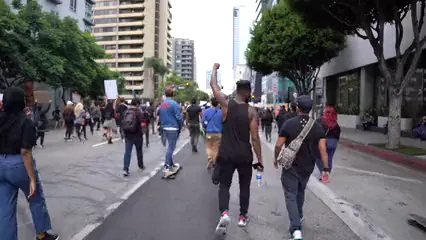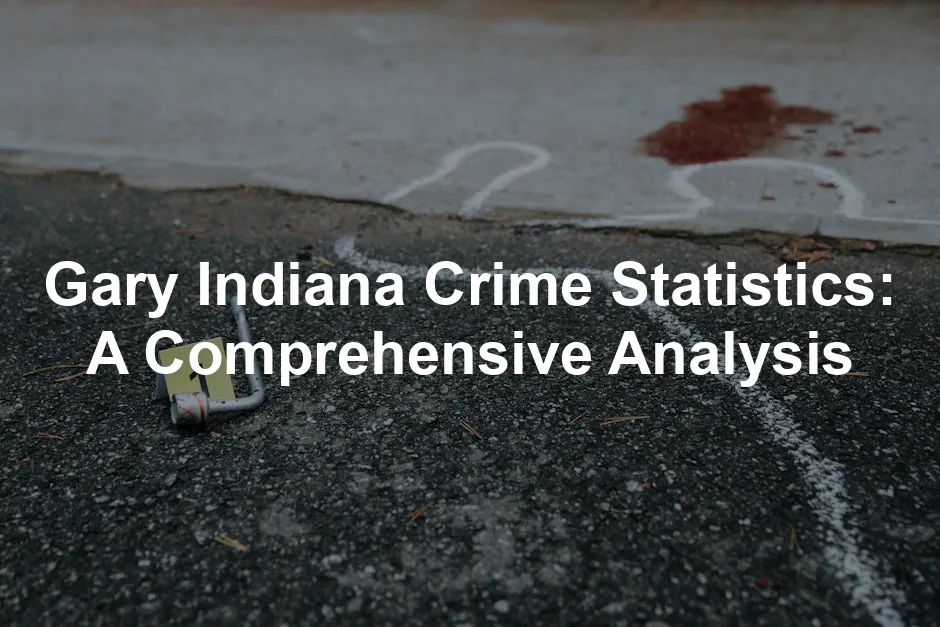Introduction
Gary, Indiana, a city with a rich yet tumultuous history, has seen its fair share of ups and downs. Founded in 1906, it thrived as a steel town, attracting workers with its promise of prosperity. However, as the steel industry declined, so did the city. Today, Gary is known for its high crime rates, which have left many residents and visitors feeling uneasy.
Understanding crime statistics in Gary is crucial for both locals and tourists. Knowledge is power, especially when navigating areas with elevated risks. The prevalence of crime impacts daily life, property values, and community safety. For residents, it can shape their perceptions of safety and well-being. For visitors, awareness can enhance their overall experience and security.
The high crime rates in Gary are not just numbers; they carry significant implications. A crime rate of 36 per 1,000 residents translates to a 1 in 28 chance of becoming a victim of any crime. This data highlights the urgent need for community awareness and proactive measures.

If you’re looking to delve deeper into the psychological aspects of crime, consider reading The Psychopath Test by Jon Ronson. This engaging read explores the murky waters of mental health and crime, providing a thought-provoking perspective on the subject.
This article will provide a thorough analysis of Gary’s crime statistics. We will examine violent and property crime rates, compare them to national averages, and explore the community’s response to these challenges. By the end, readers will gain insight into the crime landscape in Gary, Indiana, and its effects on the community.
Understanding the Crime Landscape in Gary
Historical Context of Crime in Gary
To grasp the current crime landscape, we must first look back at the historical context. Gary’s crime issues can be traced to several factors, including economic decline and industrial shifts. Once a booming steel city, Gary’s economy took a hit as factories closed and jobs disappeared. The decline of the steel industry, which once employed over 30,000 people, left many residents grappling with unemployment and poverty.
In the 1990s, Gary gained notoriety as the “murder capital” of the United States, a title that still lingers in public perception. During this time, the city recorded alarming homicide rates, peaking at over 110 murders in one year. The combination of economic despair and systemic issues created a fertile ground for crime, particularly violent crime.
Key events during this period, including gang violence and drug-related activities, further tarnished Gary’s reputation. As a result, the city faced increased scrutiny from media and law enforcement. The stigma attached to Gary as a dangerous place has been hard to shake, even as community leaders strive to turn things around.
In recent years, efforts have been made to address these challenges. Community initiatives, local policing strategies, and engagement programs aim to rebuild trust and safety in the area. However, the legacy of crime still looms large, influencing public perceptions and the experiences of those who call Gary home.
Understanding the historical context is vital for comprehending how Gary’s past shapes its present crime statistics. As we explore current crime rates and trends, we can better appreciate the ongoing efforts to reclaim the city from its troubled history.

Current Crime Rates and Trends
Gary, Indiana, continues to struggle with crime rates that are significantly higher than national averages. The overall crime rate stands at 36 per 1,000 residents, meaning there’s a 1 in 28 chance of becoming a victim of any crime. This alarming figure highlights the need for community vigilance and proactive measures.
To understand the implications of these statistics, it’s essential to look at Gary Indiana crime statistics.
If you want to understand the psychology behind crime and how it affects communities, check out The Hate U Give by Angie Thomas. This compelling narrative sheds light on the realities of crime and social justice, making it a must-read for those interested in the complexities of crime in society.
Violent Crime Statistics
Violent crimes in Gary include murder, assault, robbery, and rape. Recent statistics reveal a violent crime rate of 5 per 1,000 residents. Here’s a breakdown of violent crime figures:
- Murder: 76.3 incidents per 100,000 residents.
- Assault: 215.6 incidents per 100,000 residents.
- Robbery: 234.3 incidents per 100,000 residents.
- Rape: 28.1 incidents per 100,000 residents.
This data suggests a serious need for community safety initiatives, as the chances of falling victim to violent crime are substantially high compared to safer communities.

Property Crime Statistics
Property crime rates are even more staggering. The property crime rate in Gary is approximately 31 per 1,000 residents. Common property crimes include:
- Burglary: 759.2 incidents per 100,000 residents.
- Theft: 2,140.9 incidents per 100,000 residents.
- Motor Vehicle Theft: 656.1 incidents per 100,000 residents.
When compared to national averages, Gary’s property crime rates are significantly elevated. For instance, the national average for property crime stands around 20 per 1,000 residents. This stark contrast further emphasizes the ongoing safety challenges faced by the community.
In summary, the current crime trends in Gary paint a picture of a city grappling with high rates of both violent and property crimes. These statistics serve as a call to action for residents and local authorities to work together towards creating a safer environment.

For those interested in crime scene investigation, Crime Scene Investigation: A Guide for Law Enforcement is a valuable resource. This book provides insights into the techniques used by professionals to solve crimes, making it essential for aspiring investigators.
Neighborhood-Specific Crime Statistics
Gary, Indiana, showcases a vast array of crime statistics that vary significantly between its neighborhoods. Take Ross, for instance. This area has a reputation for higher crime rates, particularly when it comes to violent offenses. Tolleston, on the other hand, presents a mixed bag; while some streets shine with community spirit, others are shadowed by troubling crime reports.
Glen Park is a neighborhood worth mentioning, often praised for its lower crime rates compared to others in Gary. It’s a bit like the shy kid in school; it doesn’t get as much attention as others but quietly stands out for its positive aspects. However, don’t let the serene facade fool you—crime still exists here, just at a lesser frequency.
When we focus on the neighborhoods with the highest crime rates, Ross and Tolleston often top the list. Conversely, Glen Park and Aetna have emerged as some of the neighborhoods with the lowest crime rates. The stark contrasts in crime statistics within Gary showcase the importance of neighborhood awareness and community involvement to foster safety.

For those looking to understand crime from a broader perspective, The New Jim Crow by Michelle Alexander provides a critical examination of mass incarceration and its implications for society.
Demographic Factors and Crime Correlation
In Gary, demographics play a crucial role in shaping crime trends. Factors such as age, income, and education levels intertwine with crime rates, creating a complex tapestry. For example, areas with a higher concentration of young adults often report increased incidents of violent crime. Is it a case of youthful exuberance or something more systemic?
Income levels are another key player. Neighborhoods plagued by poverty frequently see elevated crime rates. Unemployment can turn desperation into crime, leading some individuals to resort to illegal activities to make ends meet. Education also plays a critical role; communities with lower educational attainment often struggle more with crime.
Gary’s challenges are deeply rooted in its economic struggles. A substantial percentage of the population lives below the poverty line. This creates a cycle where limited opportunities lead to crime, which in turn perpetuates poverty. The relationship between crime and economic instability is clear, underlining the need for comprehensive community support programs and job creation initiatives to break this cycle.

For those interested in crime prevention strategies, I recommend Safety First: A Guide to Personal Safety. This book offers practical tips and strategies for individuals to protect themselves in various situations.
Local Organizations and Activism
Gary, Indiana, has a vibrant network of community organizations dedicated to combating violence and enhancing safety. Groups such as the I Am Them Foundation actively work to address gun violence. Founded by local youth advocate Aaliyah Stewart, the foundation promotes educational initiatives and provides resources for young people to express themselves positively. Their scholarship programs encourage students to think critically about violence prevention.
The Gary Chamber of Commerce has also played a role in fostering collaboration between residents and law enforcement. They emphasize that reducing crime requires collective efforts from all community members. This approach helps build trust and accountability between citizens and police, crucial for effective crime deterrence.
However, challenges persist. Limited resources and historical stigmas about Gary complicate community efforts. Many organizations are fighting an uphill battle against ingrained perceptions that label the city as unsafe. Additionally, the economic decline has led to fewer opportunities for engagement and support, making it difficult to sustain momentum in activism.

If you’re interested in exploring crime in popular culture, I suggest watching The Wire: The Complete Series. This critically acclaimed show offers a deep dive into crime and its impact on communities, making it a relevant watch for those interested in societal issues.
Despite these obstacles, success stories exist. Crime rates have shown signs of improvement, and community forums have led to increased awareness around violence prevention. Local leaders emphasize the need for ongoing engagement, highlighting that true change requires patience and perseverance.

Recent Trends and Future Outlook
Decrease in Homicide Rates
Recent statistics indicate a promising decline in homicide rates in Gary. In 2023, the city recorded 52 homicides, a 13% decrease from the previous year. This positive trend can largely be attributed to community initiatives and innovative police strategies aimed at reducing violence.
Community organizers have implemented various programs focused on violence prevention. These initiatives include forums, anti-violence basketball games, and educational workshops that engage residents in discussions about safety. This grassroots involvement has fostered a sense of ownership and responsibility among community members, encouraging them to take an active role in shaping their environment.
The Gary Police Department has also adopted a more community-oriented approach. The establishment of the Real-Time Crime Center has enhanced their ability to respond quickly to incidents, utilizing technology to monitor crime patterns and improve communication. This proactive strategy has led to more efficient law enforcement operations, helping to deter potential criminal activity.
However, challenges remain. Economic hardship continues to affect many residents, contributing to the cycles of crime. Sustaining the momentum of community-led initiatives is critical. Law enforcement and local organizations must work together to ensure that the positive trends in homicide reduction continue.

Looking ahead, it’s essential to maintain focus on community engagement and collaboration. Ongoing support for local programs can create lasting change, transforming Gary into a safer and more vibrant community for all.
Future Challenges
Gary, Indiana, faces numerous ongoing crime challenges. Despite recent initiatives, crime rates remain disproportionately high. Gangs, drug-related activities, and economic despair continue to fuel violence. Residents often feel trapped in a cycle of fear and uncertainty.
Community engagement is essential for addressing these issues effectively. Trust between law enforcement and residents must be strengthened. Collaborative efforts can lead to innovative crime prevention strategies. Programs focusing on youth empowerment and education also play a pivotal role.
Community members need to take an active stance. When individuals unite for a common cause, they can make a significant impact. Law enforcement must foster open communication and transparency. Together, they can create a safer environment, transforming Gary into a place where residents feel secure and valued.

FAQs
What are the current crime rates in Gary, Indiana?
Gary’s crime rates remain high, with an overall crime rate of 36 per 1,000 residents. Violent crime rates stand at 5 per 1,000 residents, while property crime rates reach approximately 31 per 1,000 residents.
How does Gary’s crime rate compare to other cities in Indiana?
Gary’s crime rate is significantly higher than most Indiana cities. In fact, over 97% of communities in Indiana have a lower crime rate than Gary, making it one of the more dangerous places in the state.
What steps are being taken to improve safety in Gary?
Local law enforcement has implemented community policing strategies and initiatives like the Real-Time Crime Center. These efforts aim to enhance communication between residents and police, fostering a collaborative approach to crime reduction.
How can residents get involved in community safety efforts?
Residents can participate in neighborhood watch programs, attend community safety meetings, and engage in local initiatives aimed at reducing crime. Additionally, they can report suspicious activities to law enforcement and support local organizations working on safety issues.
Please let us know what you think about our content by leaving a comment down below!
Thank you for reading till here 🙂
All images from Pexels




